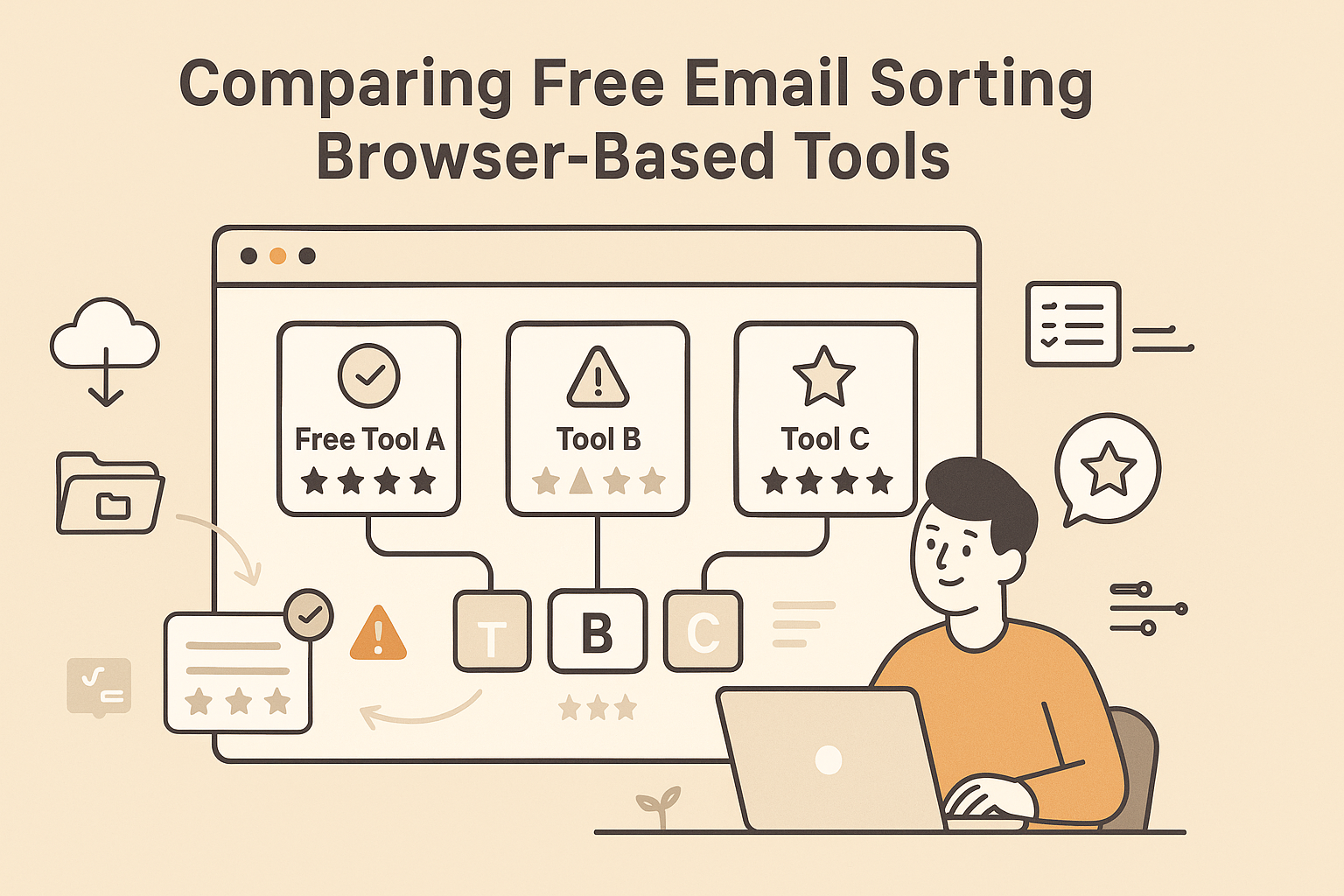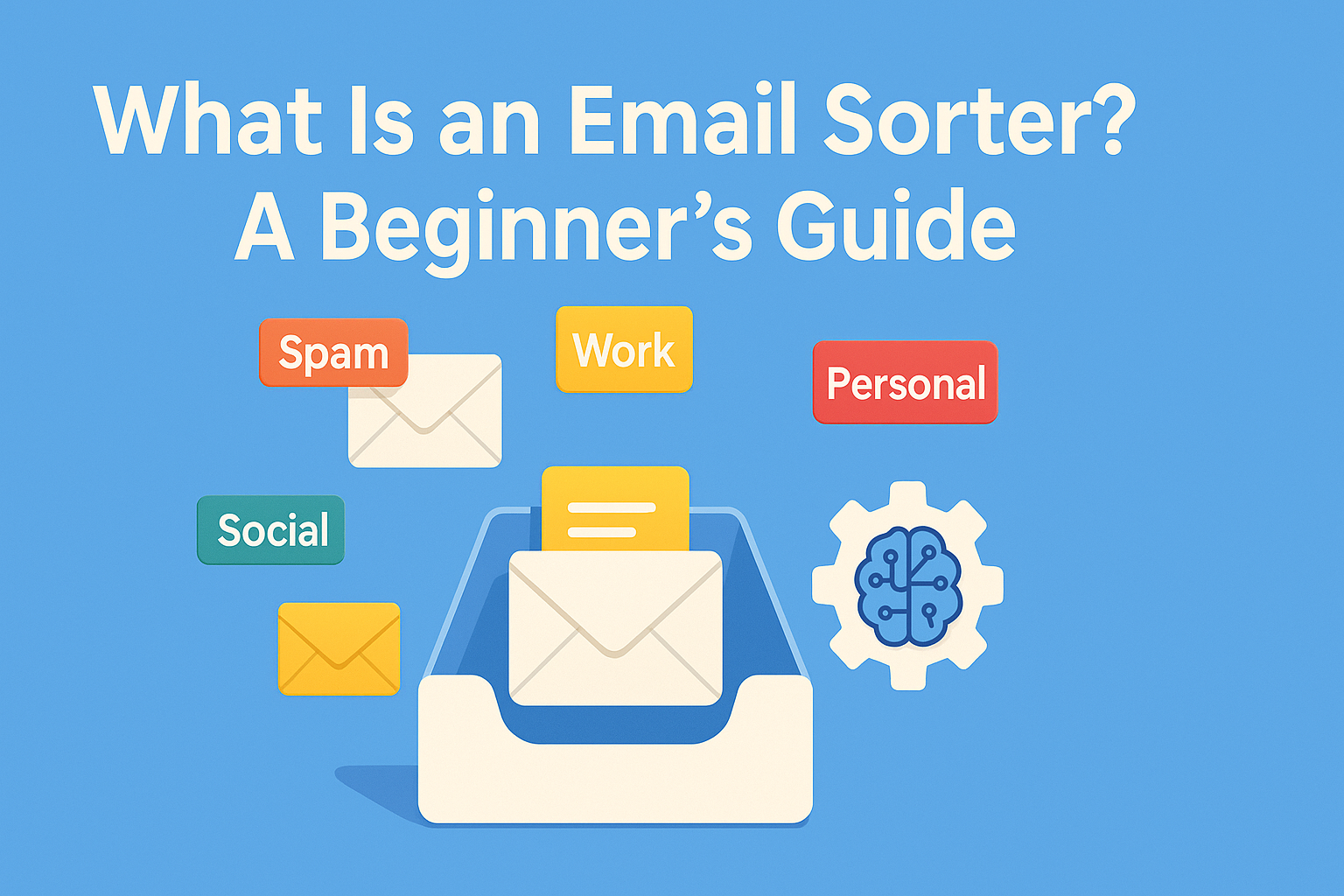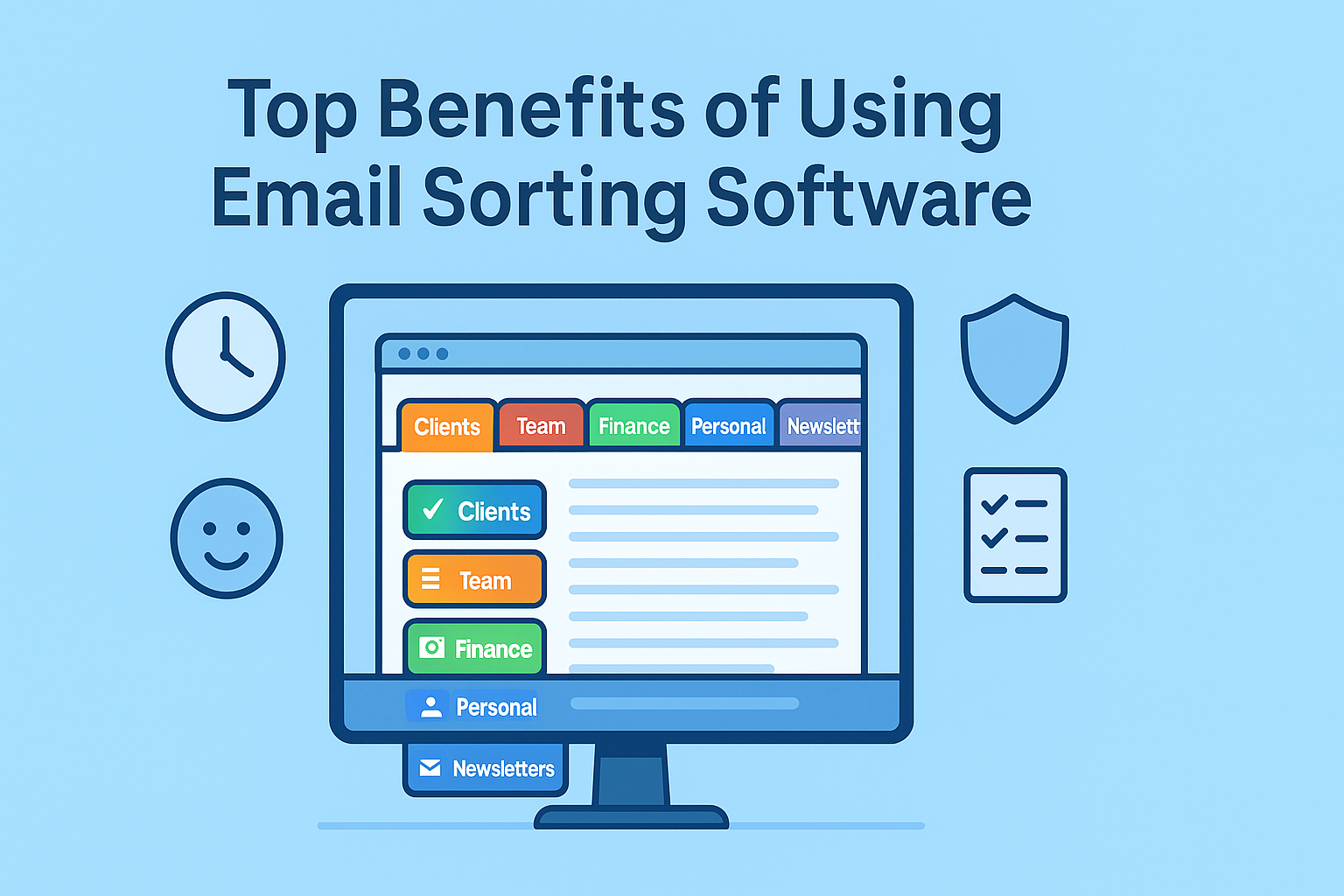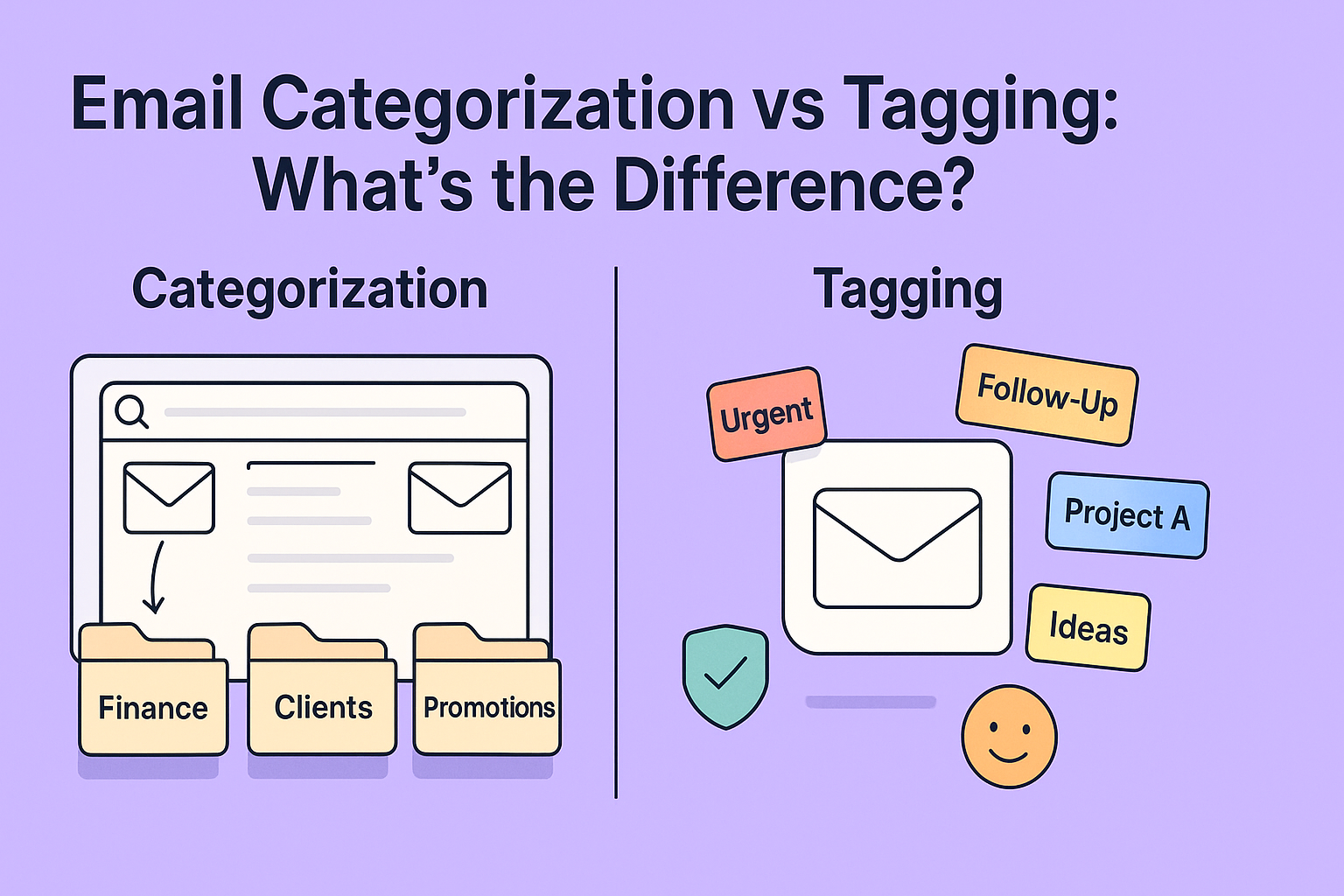Everyone with an email account eventually hits the same wall: your inbox turns into a pile of half-read newsletters, password reset links, and unread work updates. It doesn’t take long before sorting through it becomes a daily time suck. That’s where free online email sorters come in, they offer a low-commitment way to take back control without shelling out for yet another monthly subscription.
These tools help organize your inbox based on rules you set. That could mean moving receipts into a “Finance” folder, flagging anything from your boss as high priority, or auto-deleting anything that contains “limited-time offer.” And the best part? Many of them don’t cost a dime.
But free doesn’t always mean perfect. Some tools are truly useful. Others… not so much. The trick is knowing which free sorters are worth your time and what trade-offs come with the price tag of zero.
Inbox Overload and the DIY Fix
Email chaos is universal. Whether you’re a freelancer managing multiple clients or a student keeping track of school updates, your inbox fills up faster than you can manage. Most people don’t want to spend hours manually cleaning their inboxes or figuring out server-side filters.
Free online sorters are the quick fix. You don’t need IT help, you don’t need special software, and in many cases, you don’t even need to sign up. You log in, set some rules, and watch your inbox start to clean itself.
These tools aren’t just for “neat freaks,” either. They’re for anyone who’d rather spend time doing literally anything else than organizing email.
Who Benefits Most from Free Tools?
Free email sorters are perfect for individuals, small teams, or startups who just need basic control. If you’re not dealing with thousands of emails a day, you don’t need a complex enterprise-level sorter. You just want something that gets the job done, sorting the junk from the important stuff.
Students, independent contractors, early-stage entrepreneurs, these are the folks who get the most out of free sorters. They help you stay focused, avoid missing deadlines, and present a more professional inbox to the world, all without spending a penny.
What “Free” Actually Means in Email Sorting
Free” in email sorting usually means you can use basic features without paying, but advanced tools or more filters might cost extra.
Limited Features vs. Full Access
Not all free tools are created equal. Some are truly “free forever” with a decent set of features. Others give you just enough to hook you, then start pushing for upgrades.
Some free sorters let you apply unlimited rules but restrict the number of emails they’ll process per day. Others limit access to filters unless you pay. It’s worth checking what “free” really means in each case — especially if you’re relying on the tool to keep your work life organized.
Understanding this distinction helps you avoid getting stuck halfway through setup, only to realize the feature you need is locked behind a paywall.
Understanding Free Trials, Freemium, and Forever-Free Plans
There are three main kinds of free offers you’ll run into. First, the free trial — usually full-featured, but time-limited. Second, the freemium model, where the tool is permanently free but with fewer capabilities. Finally, some are truly free forever, offering core features indefinitely with optional upgrades for advanced use.
If you’re just testing the waters or figuring out what sorting can do for you, start with the truly free options. But keep the freemium ones in mind — some are worth the small investment once you know they fit your workflow.
Pros of Using Free Online Email Sorters
Using free online email sorters is great because they don’t cost anything and are easy to set up. They help keep your inbox organized without needing to sort everything by hand. Most of them work on different devices and with popular email accounts like Gmail or Yahoo. If you only need simple filters to manage your emails, free sorters are often enough without paying for extra features.
Cost Savings for Solopreneurs and Small Teams
Let’s be real: software subscriptions add up fast. Especially if you’re already paying for hosting, design tools, cloud storage, and a project management platform. A free sorter gives you inbox control without cutting into your budget.
It also lets you experiment. You can test what rules work best, figure out your tagging preferences, and even clean up old messages — all without risking buyer’s remorse. For many, a solid free tool is more than enough.
If you’re just getting started or trying to bring order to one or two accounts, a free sorter can make a real difference without costing a thing.
Quick Setup Without Technical Knowledge
No one wants to read a 12-page manual just to move an email. The beauty of free online sorters is their simplicity. Most offer a point-and-click interface, drag-and-drop rules, and no coding required.
That’s a big deal if you’re not tech-savvy. Within minutes, you can set up rules like “move anything from @linkedin.com to the Archive folder” or “highlight emails containing the word ‘invoice’.”
This ease of use lowers the barrier to entry — which means more people can start benefiting from smart inbox management right away.
The Drawbacks You Need to Know
While free email sorters are helpful, they often come with limits. You might get only basic features without advanced filters or smart automation. Some free tools show ads or have usage caps, which can be annoying. Also, they may not offer strong security or customer support if something goes wrong. If you need deeper sorting or integration with other apps, you’ll likely need to pay for a premium plan.
Feature Caps and Usage Limits
Free tools usually come with strings attached. Maybe you’re only allowed five rules, or your sorter only checks your inbox once a day. Sometimes you can’t apply filters to attachments, or you’re stuck with basic tagging options.
These limitations don’t make the tool useless, but they do shape how much it can help. That’s why it’s worth understanding what your current and future needs are. If you’re planning to scale or automate deeply, a free tool might not get you all the way.
You can explore more about choosing the right level of functionality by checking the breakdown in free vs paid email sorters, a helpful guide for deciding when it’s worth upgrading, and what features justify a price tag.
Ads, Upsells, and Hidden Costs
Some free sorters display ads or send “upgrade now” reminders after every task. Others might collect metadata to fund their services, or lock important features unless you invite friends or link additional accounts.
That doesn’t make them bad, but you’ll want to go in with eyes open. Always read the terms and see what you’re agreeing to. Free tools should help your productivity, not distract you with gimmicks or limitations.
Security and Privacy Concerns
Free email sorters can raise security and privacy concerns. Some may access your emails to show ads or collect data for marketing. They might not use strong encryption, putting your personal information at risk. Also, free tools often don’t have strict privacy policies, so your data could be shared with third parties without clear consent.
What to Look for in a Secure Free Tool
When using a free online email sorter, security should never be an afterthought. Your inbox is full of personal conversations, client info, financial statements, and sensitive data. The tool you use to organize it should treat that content with care.
Look for sorters that use HTTPS, provide clear privacy policies, and never store your emails on their servers longer than necessary. It’s also a good idea to check whether the tool processes your emails locally (or in transit only), rather than storing a copy.
Even free tools can prioritize security. Some encrypt message content during processing or use OAuth so they don’t have direct access to your login credentials.
If you’re unsure about what makes a free tool safe, take a moment to read more about the safety of free email sorters. That guide breaks down what to watch for, which red flags to avoid, and how to stay in control of your data while using third-party services.
Key Features to Expect from a Good Free Email Sorter
A good free email sorter should offer basic filters to sort emails by sender, subject, or keywords. It should work with popular email services like Gmail or Yahoo and be easy to set up without technical skills. You can also expect options to create folders or labels for better organization. Some may include simple spam filtering to keep junk out of your inbox.
Filters, Tags, Folders, and Automation Basics
A decent free sorter should give you at least a few core tools: the ability to filter emails by sender or subject, move them into folders, and maybe tag or label them. Some tools even allow auto-archiving or automatic responses, depending on the platform.
While these aren’t groundbreaking features, they’re the backbone of solid inbox management. Without them, you’re just staring at another version of the same cluttered inbox.
Automation is another area where free tools can shine. Even something simple, like sending all receipts to a “Finance” folder or archiving anything older than 90 days, can make your daily workflow faster and less frustrating.
Just remember, not every tool offers these features equally. Some might offer tagging but not custom folders, or filter by domain but not subject line. Choose the one that gives you the controls you’ll actually use.
Mobile Access and IMAP Compatibility
We live in a mobile-first world, and any good email tool should reflect that. A strong free sorter will either have a mobile-friendly dashboard or integrate directly with your IMAP provider so your rules apply no matter what device you’re using.
This is especially useful if you switch between desktop and phone throughout the day. You want your sorting rules to follow you, not reset every time you check your mail from a different screen.
IMAP compatibility is key here. It ensures that your sorter doesn’t just clean up what you see in one browser window — it keeps your email tidy across every app, every platform, every time.
The Best Picks Available Right Now
Here are some of the best free email sorters you can use right now to keep your inbox organized and save time. Each offers simple tools to help manage your emails without extra cost.
- Gmail Tabs automatically categorizes emails into tabs like Primary, Social, and Promotions using machine learning. It’s ideal for casual Gmail users seeking basic organization.
- Outlook Focused Inbox separates important emails into a “Focused” tab, while others remain in the “Other” tab. It works best for Microsoft 365 users.
- Edison Mail is a mobile-first app offering features like an AI assistant, automatic unsubscribe, and fast search capabilities.
- Chuck Email lets users manage multiple email accounts with bulk actions, subscription management, and a unified inbox. The free plan supports one email account with basic features.
- Triage is a mobile-first email sorter that lets you quickly swipe through emails to categorize them, perfect for users who manage emails on the go.
Comparison of Top 3 Free Tools by Use Case
Depending on your needs, some free sorters stand out more than others. If you’re just looking to batch delete or unsubscribe from junk, tools like Mailstrom and Clean Email offer generous free plans with a focus on quick cleanup. For users needing automation across multiple folders, Sortd and Flow-e bring a more Kanban-style approach to organizing your inbox visually.
These tools may vary in UI and extras, but they all deliver the basics: clear inboxes, simple rule-building, and enough power to handle daily email chaos.
Of course, there are dozens of other options out there. If you want a full breakdown of what’s available and which ones are worth your time, check out this roundup of the best free email sorters. It covers top-rated tools, where they excel, and which features are useful, no fluff, no gimmicks.
Exploring a range of options can help you land on the one that best fits your inbox style and workflow without wasting time on trial and error.
When to Upgrade (and Why You Might Not Need To)
You might consider upgrading when your inbox grows too big for basic filters, or you need advanced features like smart automation, multiple account support, or deeper integrations with other apps. However, if your email volume is low and simple sorting works fine, sticking with a free tool is often enough and saves you money.
Reading the Signs: Outgrowing Free Tools
There’s nothing wrong with starting small. In fact, using free tools is a smart way to understand what kind of sorting system works best for you. But there are signs that it might be time to consider a paid option.
If you find yourself hitting usage caps regularly, needing advanced filters like keyword exclusions or automation triggers based on attachments, or if your team needs to share filters and workflows, those are clues. A free tool can only take you so far.
That said, you don’t always have to upgrade immediately. Some users get creative — using multiple free tools together, or setting up manual folders that mimic automation.
A little resourcefulness can stretch a free tool’s usefulness further than you’d expect. And depending on your workflow, you might never need the premium bells and whistles.
Smart Ways to Combine Free Sorters with Other Tools
Pairing a free sorter with another tool can unlock more flexibility. Maybe your sorter handles the bulk sorting, while your email client tags things by priority. Or maybe you use a free tool like Zapier to create lightweight automations triggered by sorted emails.
The point is, you’re not limited to one solution. You can build a setup that works without going all-in on any one service.
Tips for Getting the Most from Free Sorters
To get the most from free email sorters, keep your filters simple and clear. Regularly review and update your rules to match changing email patterns. Use folders or labels to organize important emails. Take advantage of built-in features like spam filtering or unsubscribe tools. And check your sorter settings often to make sure it’s working as you want.
Rule Optimization for Clutter Reduction
Writing better rules means better results. Instead of setting one rule per sender, group by domain. Instead of archiving emails after 30 days, consider moving older ones to an “Idle” folder you review weekly.
Refining your rules isn’t complicated, it just takes a bit of observation. Check what clutters your inbox the most, and create rules that solve that specific issue. Over time, you’ll develop a sorting system that requires almost no maintenance.
Combining Filters with Folders for Speed
Folders without filters are just storage. Filters without folders are chaos. The magic happens when you combine both.
Set up your system so filtered emails land in folders based on topic, client, or urgency. That way, you know exactly where to go when you need to reply, review, or relax.
The more you automate the structure, the less energy you spend on your inbox — and the more you can focus on actual work.
Final Thoughts
You don’t need to spend money to get your inbox under control. Free online email sorters can do a lot — especially if you take a little time to set them up right and know what limitations to expect.
Sure, they’re not perfect. Some have ads. Some hold back features. But if you choose well, they’ll give you a cleaner inbox, a calmer brain, and a better handle on your digital life.
Start small, stay smart, and upgrade only when it truly makes sense. Until then, there’s no reason a zero-dollar tool can’t make you feel like you’ve got a million-dollar system.
FAQs
Are free email sorters actually effective?
Yes, many free tools offer solid basic features like rule-based filtering, auto-archiving, and tagging that significantly reduce inbox clutter.
What’s the difference between free and freemium?
Free tools give you core features with no payment required. Freemium tools start free but offer additional paid features or remove limits after upgrade.
Can I use more than one sorter together?
Absolutely. Some users combine different tools for different accounts or tasks, depending on what each tool does best.
Do free tools work with Gmail or Outlook?
Most do. As long as your email supports IMAP, many free sorters can connect and operate across major platforms like Gmail and Outlook.
Will my emails be safe using a free service?
As long as you choose a reputable tool with proper encryption and transparent data policies, your emails are generally safe. Be sure to read more on the safety of free email sorters before connecting any accounts.




